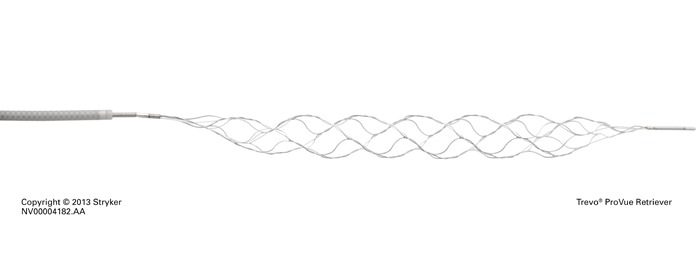
Following the expanded indication in the USA by the Food and Drug Administration (FDA) in February, the Trevo retriever (Stryker) has received CE marking as a front-line treatment for patients experiencing acute ischaemic stroke up to 24 hours from symptom onset, increasing the treatment window by 18 hours.
“The 24-hour indication opens the treatment window to patients whose stroke would previously have progressed until all the brain tissue surrounding the affected arteries was dead, leaving them with a life of significant disabilities,” says Raul Nogueira (Grady Memorial Hospital and Emory University, Atlanta, USA). “These patients now have a much better chance for an independent life without disability.”
The Trevo retriever is the first and only thrombectomy device to receive FDA clearance, and now a CE marking, to significantly reduce disability in patients up to 24 hours from symptom onset. Until now, mechanical thrombectomy devices like the Trevo retriever were only cleared for use up to six hours from symptom onset—leaving a significant population of stroke patients ineligible to receive treatment. However, recent randomised clinical data from the Stryker-sponsored DAWN trial shows that patients presenting in the six- to 24-hour window who meet specific imaging criteria and are treated with the Trevo retriever are almost four times as likely to be functionally independent at 90 days post-stroke, compared to those treated with medical management alone.
“This is a big step forward, expanding the proportion of eligible patients for mechanical thrombectomy,” says Urs Fischer (Department of Neurology, University Hospital of Bern, Bern, Switzerland). “For patients with a stroke of an unknown time of symptom onset or a wake-up stroke, a new therapeutic option is now available. However, mechanical thrombectomy should still be performed as quickly as possible, as numerous studies have shown that stroke patients treated early after symptom onset have a better outcome than patients treated late.”
The Trevo retriever was used exclusively in the DAWN trial and was included in the DEFUSE 3 study—producing the largest cohort of data for a single device across the two late window stroke trials that led to the recent updates to the American Heart Association/ American Stroke Association guidelines. Based on the depth of clinical evidence, stent retrievers like the Trevo retriever are recommended as the standard of care for stroke patients experiencing a large artery blockage by the American Heart Association’s Stroke Guidelines.
“FDA clearance and CE approval of the Trevo retriever have effectively quadrupled the treatment window from zero–six hours to zero–24 hours from time last seen well. Nonetheless, every minute still matters because in each individual patient, the earlier the blood flow is restored to the brain, the lower the resultant burden of permanent brain damage. Therefore, it is still imperative that all caregivers in the stroke pathway—from EMS to emergency room physicians to stroke neurologists to interventionalists—continue to deliver the fastest and most workflow-efficient treatment of stroke,” comments Tudor Jovin (University of Pittsburgh Medical Center, Pittsburgh, USA).












